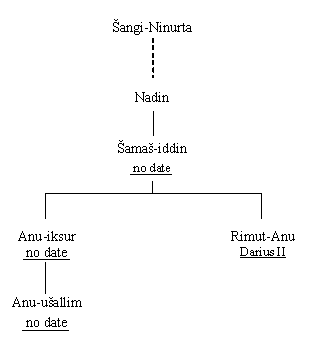The āšipus' house(s) in Uruk
Excavations and finds
From 1969 to 1972 , the German archaeologists of the Deutsche Orient-Gesellschaft excavated an important sector of south-east Uruk. In 1969, the 27th season of German excavations on the site, eight levels dating from the second half of the first millennium B.C. were unearthed, some of them late Achaemenid and Seleucid. A dwelling zone was found in the locus designated as Ue XVIII. It was excavated in 1969, 1971 and 1972. The Ue XVIII locus comprised three different levels which contained testimony of scholarly activities, all disturbed by later Parthian graves:
- Level II: a later house containing tablets related to the Ekur-zakir family during the early Hellenistic era.
- Level III: a very disturbed level which could have been the older stage of the house from level II.
- Level IV: an earlier house containing tablets from the šangi-Ninurta family in the late Achaemenid period.
The main problem concerning locus Ue XVIII is the contamination between the levels. The Parthian graves disrupted the different layers so that a lot of tablets moved from one stratum to another. But for the two houses of levels II and IV clear archaeological remains and contexts make it possible to reconstruct two different libraries, both assembled by āšipus. As tablets were found on the floors of each of the two houses, it is clear that no part of the first library was used in the later one. The two corpuses are highly distinct despite later mixing due to the Parthian graves.
Level IV: the Šangi-Ninurta family's house and library

The Šangi-Ninurta family of the āšipus' house(s) in Uruk.
This area was dug in 1972, during the 30th year of German excavations in Uruk. Here, as for level II, the archaeological remains were either in situ or in fill. In a small room (2m x 1.6m), named 4, the archaeologists found jars on a very thin bed of ashes. The jars contained tablets including 32 unbroken scholarly texts and at least 23 legal ones. Some others were just stored directly on the floor of the same room. Other tablets were found in this level but not in direct contact with the ground. In total, E. Weiher registered 180 tablets and fragments, with 97 from room 4. This house belonged to a family of scholars, who were āšipus attached to the Reš temple. It seems that teaching was one of the main purposes of the library. The most representative scholar here is Anu-ikṣur, son of šamaš-iddin but three generations appear in the texts as scribes or owners of the tablets.
Level III
Level III is much more problematic since it was highly disturbed by later Parthian graves but also by the building of level II. The plan of the house found here is largely the same as in level II and also has the same orientation of the earlier building in level IV. The archaeologists unearthed many objects which are relevant to scribal activities. In the south-east of room 7, near a grave, an asphalted work surface made of bricks was uncovered. On this surface and around it, the archaeologists found small dark clay lumps preformatted as tablets. In room 3 some other blank tablets were found, that had been prepared with rulings. Bone styluses were also unearthed there.
Level II: the Ekur-zakir family's house and library

The Ekur-zakir family of the āšipus' house(s) in Uruk.
The later house was built to the same orientation as the earlier one in level IV. It belonged to the family of Ekur-zakir, well known for its āšipūtu activities in the Rēš temple . The clearest remains were unearthed in the north-west wall of room 1, where a niche contained tablets of various formats, all baked. The tablets had been placed vertically, one against the other. It seems that during the excavations no clear registration of the tablets' arrangement on those shelves was made.
Another group of tablets was discovered in fill in the south-west part of the same room. On the floors of all rooms the archaeologists found broken baked tablets.
Finally, there was an oven in room 3. For M. Hoh, its most probable function was to bake the tablets. Seven tablets were found against the north-west wall of this room: four were badly modelled and three very finely, none of them inscribed.
The āšipūtu professional activities of the house owners and the special teaching function of this place contribute to making this an important library. Almost all the scribes whose texts were discovered in the house were from the Ekur-zakir family. The most representative scholar in this corpus is Iqiša, son of Ištar-šum-ereš but four different generations appear in it.
The tablets today

The Uruk āšīpus' scholarly network. View the Uruk āšipus' scholarly network in Google Maps.
Together the libraries contained 419 scholarly tablets and 48 legal and administrative documents. The tablets are published in SpTU. Today they are in the National Museum of Iraq, Baghdad.
Bibliography
- Hoh, '29. Kampagne', 1979.
- Hunger, SpTU I, 1976.
- Sack, '30. Kampagne', 1979.
- Schmidt, 'Ue XVIII 1', 1979.
- von Weiher, SpTU II, 1983.
- von Weiher, SpTU III, 1988.
- von Weiher, SpTU IV, 1993.
- von Weiher, SpTU V, 1998.
Philippe Clancier
Philippe Clancier, 'The āšipus' house(s) in Uruk', The Geography of Knowledge, The GKAB Project, 2019 [http://oracc.museum.upenn.edu/cams/gkab/contexts/ipushouses/]